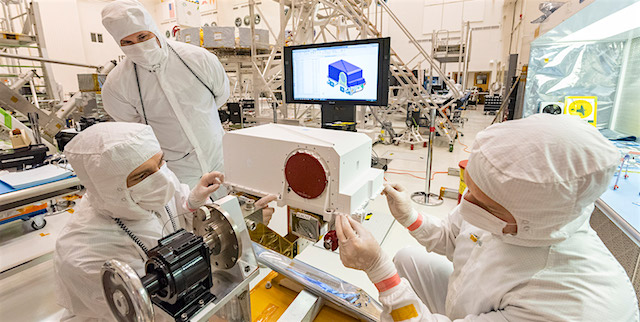 One of the first operations the Mars 2020 rover will perform after touching down on the Red Planet’s Jezero Crater on Feb. 18, 2021, will be to raise its remote sensing mast (RSM), which carries important optics and instrumentation.
One of the first operations the Mars 2020 rover will perform after touching down on the Red Planet’s Jezero Crater on Feb. 18, 2021, will be to raise its remote sensing mast (RSM), which carries important optics and instrumentation.
In this picture – taken on May 23, 2019, in the Spacecraft Assembly Facility’s High Bay 1 clean room at the Jet Propulsion Laboratory in Pasadena, California – engineers re-install the cover to the RSM head after integration of two Mastcam-Z high-definition cameras. Visible below the red lens cover is the left Mastcam-Z camera (with the “Remove Before Flight” labels); support equipment blocks the right Mastcam-Z from view. The RSM and its twin cameras will be installed on the rover’s deck the week of June 3, 2019.
Mastcam-Z is a multispectral, stereoscopic imaging instrument that will enhance the Mars 2020 rover’s driving and core-sampling capabilities. It will also enable science team members to observe textural, mineralogical, structural and morphologic details in rocks and sediment at any location within the rover’s field of view, helping them piece together the planet’s geologic history.
“Mastcam-Z will be the first Mars color camera that can zoom, enabling 3D images at unprecedented resolution,” said Mastcam-Z Principal Investigator Jim Bell of Arizona State University in Tempe. “With a resolution of three-hundredths of an inch [0.8 millimeters] in front of the rover and less than one-and-a-half inches [38 millimeters] from over 330 feet [100 meters] away – Mastcam-Z images will play a key role in selecting the best possible samples to return from Jezero Crater.”








